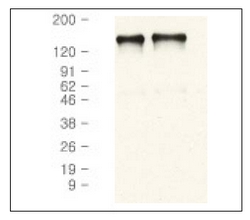EGFR Rat Monoclonal Antibody [Clone ID: SB41a]
Specifications
| Product Data | |
| Clone Name | SB41a |
| Applications | IHC, WB |
| Recommended Dilution | Western Blot: 1-2 µg/ml. Immunohistochemistry: FS or cultured and Methanol-Fixed Cell Lines): 10 µg/ml |
| Reactivities | Human |
| Host | Rat |
| Isotype | IgG2a |
| Clonality | Monoclonal |
| Immunogen | Recombinant human EGFR. |
| Specificity | This antibody reacts with human EGFR (150 kDa). It reacts specifically with the EGFR but does not react with Her-2 recombinant protein. |
| Formulation | 100 mM Borate buffered saline, pH 8.2 without preservatives. State: Purified State: Liquid purified Ig fraction. |
| Concentration | lot specific |
| Storage | Store the antibody undiluted at 2-8°C for one month or (in aliquots) at -20°C for longer. Avoid repeated freezing and thawing. |
| Stability | Shelf life: one year from despatch. |
| Database Link | |
| Background | Epidermal growth factor receptor (EGFR) is a transmembrane receptor for epidermal growth factor (EGF). It is a member of the ErbB family of receptors, a subfamily of four closely related receptor tyrosine kinases: EGFR (ErbB -1), HER2/c-neu (ErbB-2) Her 3 (ErbB-3 and Her 4 (ErbB-4). EGFR exists on the cell surface as inactive monomers and is activated by binding of its specific ligands, including EGF, transforming growth factor alpha (TGFalpha), or others. Upon activation, EGFR can pair with another EGFR to form an active homodimer or an EGFR may pair with another member of the ErbB receptor family, such as Her 2/c-neu, to create a heterodimer. Evidence also suggests that a cluster of active EGFR can form. (Ref.1-3) The binding of ligand stimulates the intrinsic protein-tyrosine kinase activity of EGFR which initiates a signal transduction cascade leading to DNA synthesis and cell proliferation. The kinase activity can also result in autophosphorylation of the five tyrosine residues in the C-terminal domain of EGFR. Autophosphorylation elicits downstream activation and signaling events of other proteins that are often distinct from those activated by the kinase domain of EGFR. Such proteins modulate phenotypes such as cell migration, adhesion, and proliferation. The kinase domain of EGFR can also cross-phosphorylate tyrosine residues of other receptors it is aggregated with, and can itself be activated in this manner. Mutations that lead to EGFR overexpression or overactivity have been associated with many common solid human squamous cell carcinomas including breast, brain, bladder, lung, gastric, head and neck, esophagus, cervix, vulva, ovary, and endometrium. (Ref.4-7) EGFR and ErbB -2 are particularly important in breast cancer because increased production or activation has been associated with poor prognosis. Tumor aggressiveness and patient outcome can be directly correlated to the production levels. Inhibitors of EGFR represent an emerging new class of anti-cancer drugs that target the underlying molecular changes involving oncogenes and tumor suppressor genes, genes that play critical roles in the conversion of normal cells into a cancerous state. |
| Synonyms | Epidermal growth factor receptor, EGF Receptor, erbB-1, c-ErbB-1 |
| Reference Data | |
Documents
| Product Manuals |
| FAQs |
{0} Product Review(s)
0 Product Review(s)
Submit review
Be the first one to submit a review
Product Citations
*Delivery time may vary from web posted schedule. Occasional delays may occur due to unforeseen
complexities in the preparation of your product. International customers may expect an additional 1-2 weeks
in shipping.






























































































































































































































































 Germany
Germany
 Japan
Japan
 United Kingdom
United Kingdom
 China
China



